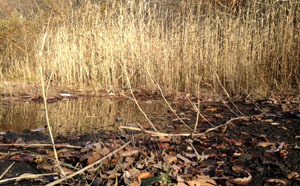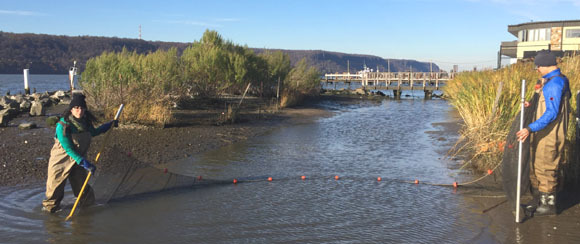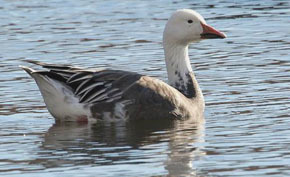Hudson River Almanac 11/18/17 - 11/24/17
The New York State Department of Environmental Conservation sent this bulletin on 12/01/2017 02:32 PM EST |
| DEC Delivers - Information to keep you connected and informed from the NYS Department of Environmental Conservation |
| Share or view as a web page || Update preferences or unsubscribe |
|
|
We had a visit from a rare Arctic sea duck this week. Late fall through late winter seems to be the time for these sightings of uncommon wintering waterfowl. From unexpected to expected, our winter ducks are finding every pond, lake, and river in the watershed. HIGHLIGHT OF THE WEEK 11/18 – Saratoga County, HRM 182: We came upon a male harlequin duck on Saratoga Lake today swimming in front of the Sewage Treatment Plant gate on the south side of the lake. While the duck was diving by itself, not far away were common goldeneye (20) and Canada geese (10).
NATURAL HISTORY ENTRIES 11/18 – Kowawese, HRM 59: It was cold and dreary with a steady rain and a stiff southeast wind blowing up through the Hudson Highlands, an appropriate setting for the end of the shorts, sandals, and seining season. The tide made for an evening haul – it was totally dark. Headlamps provided weak illumination. It seemed like we were saying good-bye to a dear friend who was going away for five months. The water was 48 degrees Fahrenheit; the salinity had bottomed out at 0.0 parts-per-thousand and we had little to no expectations. However, as we slid the seine up on the sand we were encouraged to see some movement in the net. The season was not quite over. The “locals” were there, a dozen white perch and a like number of spottail shiners. And then the prize, as we looked upon young-of-the-year [YOY] striped bass 80-87 millimeters [mm] long still migrating to the sea. [Note: one inch = 25.4 millimeters] 11/18 – Bedford, HRM 35: Very little activity today at the Chestnut Ridge Hawkwatch. Red-tailed hawks were a modest high count with three. There were also two Cooper’s hawks and one bald eagle. Non-raptor observations included cedar waxwings (30) and common grackles (250). 11/19 – Minerva, HRM 284: There was snow in the High Peaks of the Adirondacks but we only had a dusting here in the foothills. On a cold, raw, grey day, just below freezing, we took a walk to the “back forty.” There we found an inch of ice of unknown strength on our woodland pond. During this early cold-weather season, it is extremely important to know the strength of the ice before you venture out on it. 11/19 – Bedford, HRM 35: Red-tailed hawks (11) seem unfazed by the strong winds at the Chestnut Ridge Hawkwatch. Turkey vultures were high count among migrants (29). Non-raptor observations included ring-billed gulls (180). 11/20 – Bedford, HRM 35: Turkey vultures (25) were again the high number today at the Chestnut Ridge Hawkwatch. Red-tailed hawks (19) were high count among raptors and red-shouldered hawks (9) made a good showing as well. Non-raptor observations included common ravens (5). 11/20 – Hook Mountain, HRM 31: We saw eight bald eagles at the Hook Mountain Hawkwatch today, five adults and three immatures. We also counted seven high-flying black vultures, a group of three and a group of four. At midday, a lone female northern harrier crossed the sky heading southwest. She was working hard with very deep wing beats and lots of twists and turns. Later, a red-shouldered hawk was blown up from the south, blown back, and then began working its way back to us. There was little doubt that it wanted to migrate but the wind was too much. 11/21 – Saratoga County, HRM 184: With the sun in good position for observing waterfowl, I went to Loughberry Lake today. I was initially surprised to see somewhat fewer ducks than expected although I did spot a single drake redhead. I moved to view the southern area of the lake and found it packed with almost entirely ring-necked ducks (estimated 900) with a layer of Canada geese (450) beyond. I had to take three photos to get the breadth of the ring-necked raft. 11/21 – Saratoga County, HRM 182: I found a hen canvasback today in the general vicinity of the ongoing search for the harlequin duck. This experience of careful observation has re-taught me the wisdom of my ornithology professor, “Bird every bird.” Among the 33 species I counted today (most were “diver ducks”) were surf scoters (3), white-winged scoters (5), black scoters (6), bufflehead (107; yes, I counted them), common goldeneye (135; yes, I counted them too), red-throated loon (2), common loon (5), red-necked grebe (2), and horned grebe (18). I suspected there were many more of the latter grebes but they kept popping up and down all over and were difficult to see and count with a chop on the water. [Diver ducks and dabbler ducks. Diver ducks dive. Most are predators of fish and shellfish. To make them good underwater swimmers, diving ducks' feet are situated farther back on their bodies. What they gain for swimming they sacrifice in walking. They are awkward on land which is why you will see dabbling ducks more often ashore than divers. Dabbler ducks can dive, they just tend not to. They generally forage on vegetation that is not more than neck deep, and are often seen “butt end up, neck down” in shallow water. Diver ducks generally need a long runway to get airborne while dabblers, or puddle ducks, can usually simply spring up. Barbara Butler, Tom Lake.] 11/21 – Hoosic River, HRM 172: With a cold night, the ponds were skimmed with ice. I had not seen the bobcat that I spotted a while ago in our northern Hoosic River watershed meadow where it had been feeding on a white-tailed deer carcass. However, eight ravens helped with the scavenging and along with two immature bald eagles they picked it clean in three days. 11/21 – Norrie Point, HRM 85: Erik Kiviat pointed out to me a great example of a phragmites stolon (see definition below) extending from the edge of the Norrie Point parking lot over the weathered pavement. Phragmites (Phragmites australis) is a perennial, aggressive wetland grass that out-competes native plants and displaces some native animals. It grows readily in disturbed wetland areas, such as degraded salt and freshwater marshes and swamps, along streams, lakes, ponds and roadside ditches.
[Genetic studies have confirmed that there is a native variety of phragmites (Phragmites australis americanus) along the east coast of the U.S. and in a few New England marshes. Visit the U.S. Fish and Wildlife Service's phragmites webpage for more information on the native species.] 11/21 – Croton-on-Hudson, HRM 34: This was a very slow fishing day for carp and catfish. After weighing and measuring, I released my only catch (in fact my only bite) of the day, a gorgeous channel catfish (24 inches, 4 pounds 5 ounces). 11/21 – Bedford, HRM 35: There were very few birds moving today at the Chestnut Ridge Hawkwatch. We spotted both an adult and an immature bald eagle that did not seem to moving out so they were not counted. Turkey vultures (9) were the high count among migrants with red-shouldered hawks (3) high for raptors. Our total migrant count reached just shy of 9,000 for the season. On this date last year, our total migrant count was 3,509. Non-raptor observations included Canada geese (20) and cedar waxwings (32). 11/21 – Hook Mountain, HRM 31: A tiercel [male falcon] zoomed like an F-18 all over the southwest bowl at the Hook Mountain Hawkwatch before alighting in rockslide trees on the sunny east face of Nyack Ridge. A high kettle of migrating turkey vultures (15) also held an immature bald eagle. A raptor passed fairly close along the south side. I quickly realized that it was not a red-shouldered hawk—it was flapping like a Cooper's hawk. It looked like a Cooper's hawk but it was too massive. I was flummoxed until I remembered Vince Plogar's maxim: “if a raptor looks like a buteo as well as an Accipiter, it is a goshawk!” The bird worked its way southwest passing Nyack Ridge and was counted as a northern goshawk. The non-migrant observations of note included ravens and unaffiliated turkey vultures. A croaking raven floated close along the south cliff, catching my attention, and when I glassed it a small raptor darted out from the edge then quickly back into the trees. The raven was joined by a second raven and they flew away west. I still remembered the brief look at the raptor and a half-hour later a bird popped up exactly where the little raptor had vanished earlier. It was a lovely merlin! I watched for several minutes as the little falcon climbed and dropped, up and down, fixed-wing vertical zig-zags directly past the Nyack Ridge into the southwestern distance. It was a good end to the day.
11/22 – East Fishkill, HRM 66: It was appropriate on Thanksgiving Eve that 50 wild turkeys came out of the woods, climbed over the stone wall in our yard, and then paraded across. They were disciplined in their march with the older birds seemingly in charge. I also found some pretty conclusive evidence with my feeders that a black bear had been around last night. 11/22 – Bedford, HRM 35: Although there were plenty of local and stopover birds in the air from the start of the count at the Chestnut Ridge Hawkwatch, no migrants were recorded for the first two hours. Then, in mid-afternoon, the turkey vultures (12) began moving. By day’s end we had recorded only one raptor, a peregrine falcon. Non-raptor observations included three flocks of ring-billed gulls (32), four flocks of cedar waxwings (4), and common ravens (2).
[While snow geese are typically snowy white except for their black wing tips, there are some snow geese that have a genetic color variation. Their bodies tend to be blueish-gray with white heads. These are referred to as “blue geese,” or “blue morphs.” Tom Lake.] 11/23 – Clinton Point, HRM 69: “Bird every bird,” a maxim from Ron Harrower’s ornithology professor, came to me today as I scanned Cobalt Lake, a quarry lake created by damming the Casperkill. Spread out over the quiet water were dozens of drake and hen common mergansers. It was easy to conclude there was nothing more. But in a third pass over them I spotted a drake red-breasted merganser and a female canvasback, two ducks that at first, even second glance, could easily have been missed. [See banner photo of female common merganser with bluegill courtesy of Deborah Tracy-Kral.] [Cobalt Lake, about a half-mile upland from the Hudson River, appears to favor diving ducks and cormorants. I often wonder what is in the lake that attracts them. From upstream in the Casperkill watershed, there are sunfishes and yellow perch. From downstream in the river there are similar species as well as white perch, gizzard shad, possibly even a land-locked population of river herring. Tom Lake.] 11/24 – Battenkill, HRM 193: I photographed an immature golden eagle with a distinctive white band on its tail and a dark brown head flying above the Battenkill today Over the last couple of weeks, I have also had three bald eagle sightings, all within close proximity of Route 29 and the Battenkill between Salem and Greenwich. The most recent was an immature feeding on a white-tailed deer carcass. I also spotted a northern goshawk, a rather regular sighting of this species in that area over the last couple of years. 11/24 – Staatsburg, HRM 86: It was a beautiful day to be at Mills Mansion New York State Historic Site. Looking across the river to the Ulster County side in midday, I was able to see a common loon, a dozen common goldeneyes, and six buffleheads. HUDSON RIVER MILES The Hudson is measured north from Hudson River Mile 0 at the Battery at the southern tip of Manhattan. The George Washington Bridge is at HRM 12, the Tappan Zee 28, Bear Mountain 47, Beacon-Newburgh 62, Mid-Hudson 75, Kingston-Rhinecliff 95, Rip Van Winkle 114, and the Federal Dam at Troy, the head of tidewater, at 153. The tidal section of the Hudson constitutes a bit less than half the total distance – 315 miles – from Lake Tear of the Clouds to the Battery. Entries from points east and west in the watershed reference the corresponding river mile on the mainstem. TO CONTRIBUTE YOUR OBSERVATIONS OR TO SUBSCRIBE The Hudson River Almanac is compiled and edited by Tom Lake and emailed weekly by DEC's Hudson River Estuary Program. Share your observations by e-mailing them to trlake7@aol.com. To subscribe to the Almanac (or to unsubscribe), use the links on DEC's Hudson River Almanac or DEC Delivers web pages. Discover New York State Conservationist - the award-winning, advertisement-free magazine focusing on New York State's great outdoors and natural resources. Conservationist features stunning photography, informative articles and around-the-state coverage. Visit the Conservationist webpage for more information. USEFUL LINKS National Oceanic and Atmospheric Administration online tide and tidal current predictions are invaluable when planning Hudson River field trips. For real-time information on Hudson River tides, weather and water conditions from twelve monitoring stations, visit the Hudson River Environmental Conditions Observing System website. Information about the Hudson River Estuary Program is available on DEC's website at http://www.dec.ny.gov/lands/4920.html . Smartphone app available for New York outdoor enthusiasts! Copies of past issues of the Hudson River Almanac, Volumes II-VIII, are available for purchase from the publisher, Purple Mountain Press, (800) 325-2665, or email purple@catskill.net
|


 [The harlequin duck (Histrionicus histrionicus) is a small and colorful sea duck. Roger Tory Peterson describes their breeding range as the Canadian Arctic with a winter range in the Canadian Maritimes. According to the Birds of North America Online, its present population in eastern North America is low compared to historical numbers, but seems to be increasing. That said, inland winter records on Atlantic Coast are rare. Tom Lake. Photo of male harlequin duck by Glen Smart courtesy of U.S. Fish and Wildlife Service.]
[The harlequin duck (Histrionicus histrionicus) is a small and colorful sea duck. Roger Tory Peterson describes their breeding range as the Canadian Arctic with a winter range in the Canadian Maritimes. According to the Birds of North America Online, its present population in eastern North America is low compared to historical numbers, but seems to be increasing. That said, inland winter records on Atlantic Coast are rare. Tom Lake. Photo of male harlequin duck by Glen Smart courtesy of U.S. Fish and Wildlife Service.] [A stolon is a horizontal stem on the ground surface that produces both vertical shoots (culms) and roots from the nodes when it reaches suitable substrate. Stolons allow phragmites (and some other species) to cross unfavorable ground such as a railroad. Stolons are on the surface and rhizomes (also shoot and root producing stems) are underground. Erik Kiviat. Photo of stolon extending out from phragmites bed courtesy of Chris Bowser.]
[A stolon is a horizontal stem on the ground surface that produces both vertical shoots (culms) and roots from the nodes when it reaches suitable substrate. Stolons allow phragmites (and some other species) to cross unfavorable ground such as a railroad. Stolons are on the surface and rhizomes (also shoot and root producing stems) are underground. Erik Kiviat. Photo of stolon extending out from phragmites bed courtesy of Chris Bowser.]
 11/23 – Town of Stanford, HRM 88: In the midst of a huge raft of Canada geese on Hunn’s Lake was a single blue morph snow goose. [Photo of blue morph snow goose courtesy of Deborah Tracy-Kral.]
11/23 – Town of Stanford, HRM 88: In the midst of a huge raft of Canada geese on Hunn’s Lake was a single blue morph snow goose. [Photo of blue morph snow goose courtesy of Deborah Tracy-Kral.]